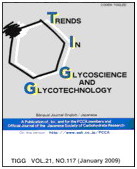All issues

Volume 22 (2010)
- Issue 128 Pages 269-
- Issue 127 Pages 211-
- Issue 126 Pages 173-
- Issue 125 Pages 93-
- Issue 124 Pages 55-
- Issue 123 Pages 1-
Volume 22, Issue 126
Displaying 1-6 of 6 articles from this issue
- |<
- <
- 1
- >
- >|
MINIREVIEW
-
Akikazu Fujita, Toyoshi FujimotoArticle type: MINIREVIEW
2010 Volume 22 Issue 126 Pages 173-181
Published: 2010
Released on J-STAGE: October 07, 2010
JOURNAL FREE ACCESSBiological membranes at ambient temperature show fluidity in two dimensions. Both proteins and lipids, however, do not necessarily distribute evenly but often have a biased distribution. Methods to visualize membrane lipids are limited compared to those for membrane proteins, and distribution of endogenous lipids has been difficult to analyze quantitatively. We recently developed a method to immobilize membrane lipids physically by combining quick freezing and freeze-fracture techniques, whereby we could observe their two-dimensional distribution at the nanoscale. The method has a high capture ratio, and the point pattern analyses can be applied to the result. This article mainly discussed the results obtained for gangliosides GM1 and GM3 and also referred to the results for phosphatidylinositol 4,5-bisphosphate.View full abstractDownload PDF (748K) -
Yusuke Maeda, Morihisa Fujita, Taroh KinoshitaArticle type: MINIREVIEW
2010 Volume 22 Issue 126 Pages 182-193
Published: 2010
Released on J-STAGE: October 07, 2010
JOURNAL FREE ACCESSPost-translational modifications to proteins play important roles in biological function, and alteration of these modifications according to cellular conditions is a sophisticated way to regulate protein activity. Glycosylphosphatidylinositol (GPI) is a glycolipid covalently attached to proteins, and it represents a post-translational modification that anchors proteins to the plasma membrane--called a GPI-anchor. The GPI-anchor is conserved among all eukaryotes and more than 150 proteins of various functions are modified with a GPI-anchor. The GPI-anchor is essential for the growth of yeasts and some protozoans, and defects in GPI-anchors are associated with a number of human diseases. This review focuses on the recent progress and topics in mammalian GPI-anchor biosynthesis, structural remodeling and diseases associated with GPI-anchor dysfunction.View full abstractDownload PDF (823K)
GLYCODEBUT
-
Yasuhiko Kizuka, Shogo OkaArticle type: GLYCODEBUT
2010 Volume 22 Issue 126 Pages 194-199
Published: 2010
Released on J-STAGE: October 07, 2010
JOURNAL FREE ACCESSHNK-1 carbohydrate is highly expressed in the nervous system and is involved in higher-order brain functions such as learning and memory. HNK-1 has a unique structure with sulfated glucuronic acid attached to the non-reducing end of N-acetyllactosamine (HSO3-3GlcAβ1-3Galβ1-4GlcNAc-). Two glucuronyltransferases and a sulfotransferase play key roles in its biosynthesis. We focused on how these enzyme activities are regulated in terms of HNK-1 expression. We revealed that the transferases form a hetero-complex for the efficient biosynthesis and that the activity is regulated by well-controlled intracellular localization. These facts indicate that HNK-1 expression is strictly regulated through multiple control mechanisms of the biosynthetic enzyme activity.View full abstractDownload PDF (474K) -
Kotone SanoArticle type: GLYCODEBUT
2010 Volume 22 Issue 126 Pages 200-206
Published: 2010
Released on J-STAGE: October 07, 2010
JOURNAL FREE ACCESSVitronectin (VN) is a multifunctional glycoprotein present in plasma and the extracellular matrix (ECM). VN binds to various biological ligands and it plays a key role in tissue remodeling by regulating cell adhesion and fibrinolysis. The present study attempted to determine the glycan structures and how alternations of glycans modulate the biological activity of VN during liver regeneration. Plasma VN was purified from partially hepatectomized (PH) and sham-operated (SH) rats at 24 hours after operation and non-operated (NO) rats. The liquid chromatography/ multiple-stage mass spectrometry analysis of glycopeptides of each VN determined the site-specific glycosylation. With the major complex-type N-glycans, hybrid-type N-glycans were site-specifically present. The complex-type N-glycans decreased in PH-VN while the fucosylation ratio was increased. Highly sialylated O-glycans were found to be present in the Thr110-Thr124 region, which contained α2,8-linked disialic acid and dramatically decreased after PH. Further study using ultracentrifugation demonstrated that the multimer sizes of PH-VN significantly increased compared with NO-VN. In accordance with this, PH-VN exhibited remarkably enhanced collagen-binding than NO-VN. The results indicate that glycan alterations during tissue remodeling induce increased multimerization state to enhance collagen-binding of VN.Adhesion of rat hepatic stellate cells (HSCs), together with phosphorylation of focal adhesion kinase (FAK), in PH-VN was decreased to half of that in NO- or SH-VN. Adhesion of HSCs in desialylated NO-VN decreased to 1/2 of that of control VN, indicating the importance of sialylation of VN for activation of HSCs. This study proposes that the alteration of glycosylation of VN is very significant in the modulation of the biological activity of VN during many steps of tissue remodeling processes. The elucidation of the molecular mechanisms of liver regeneration from the viewpoint of alterations in glycosylation of VN may contribute to the development of a strategy to regulate matrix deposition in liver cirrhosis.View full abstractDownload PDF (711K)
GLYCOTOPIC
-
Kohtaro GotoArticle type: GLYCOTOPIC
2010 Volume 22 Issue 126 Pages 207-208
Published: 2010
Released on J-STAGE: October 07, 2010
JOURNAL FREE ACCESSDownload PDF (726K) -
Tsuyoshi IchiyanagiArticle type: GLYCOTOPIC
2010 Volume 22 Issue 126 Pages 209-210
Published: 2010
Released on J-STAGE: October 07, 2010
JOURNAL FREE ACCESSDownload PDF (641K)
- |<
- <
- 1
- >
- >|